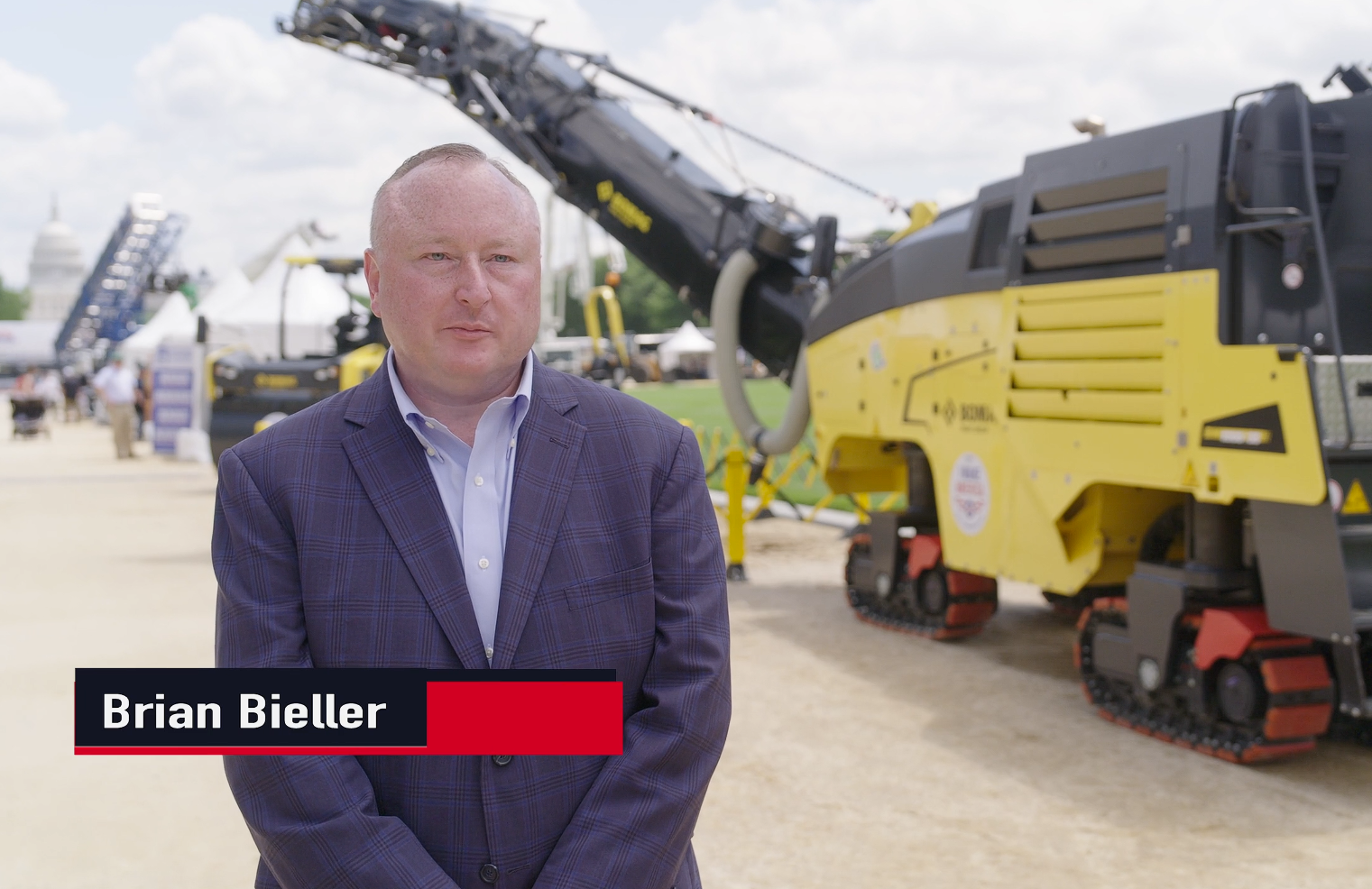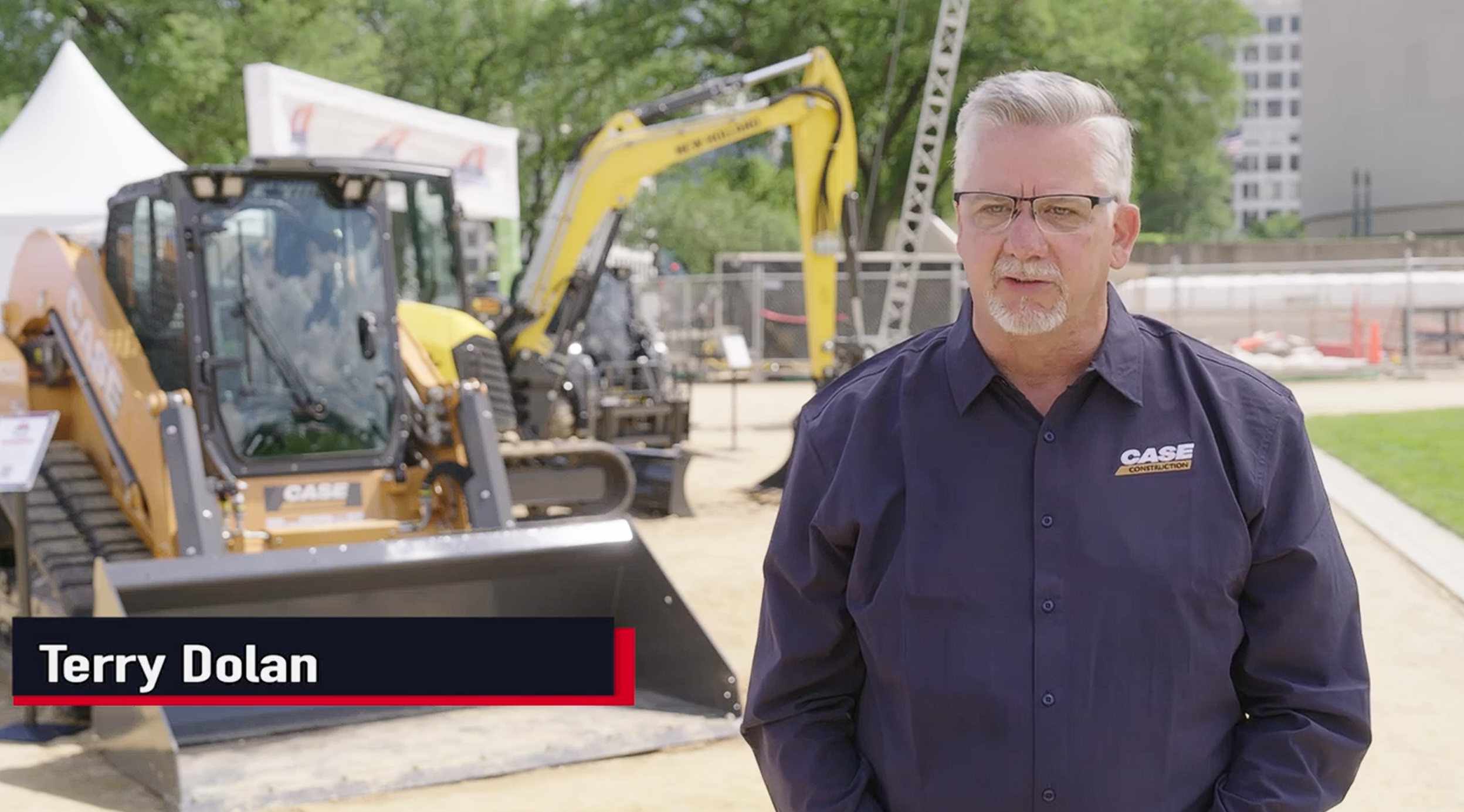It’s hard to ignore the increasing attention autonomous construction equipment is receiving.
Heavy equipment autonomy announcements in just the past year include:
- SafeAI and Obayashi Corporation demonstrating a retrofitted autonomous Cat 725 articulated truck.
- Shantui developing an unmanned dozer
- SRI International’s video on its prototype robotic excavator
- Autonomous Solutions, Inc. (ASI) partnering with Epiroc Drilling Solutions on its Mobius autonomy platform for drills
- Trimble’s new automatic steering control for soil compactors
But will we ever get to the time where humans are rare on a jobsite? And is that even the point?
“The industry is absolutely massive, the pain points are huge, and it’s early days for autonomy.” -- Teleo's Vinay Shet
AEM is committed to taking an active role in examining and shaping a shared industry vision for the future of building, so as to offer equipment solutions and insights to help the construction industry succeed. In support of that goal, we have released The Future of Building, a whitepaper highlighting the most significant trends impacting construction in the years to come. Learn more.
The coming transition will follow automotive gains.
First, a quick review.
All industries, including construction, have been the beneficiaries of U.S. defense research, said Bibhrajit Halder, founder and CEO of SafeAI. This included the DARPA (or Defense Advanced Research Projects Agency) Grand Challenge in the early 2000s, designed to accelerate autonomous vehicle technologies.
“That was a trigger point,” said Halder, whose company concentrates on bringing autonomous solutions to construction and mining. “It was a massive success that really sparked autonomy in this country.”
In 2014, the Society of Automotive Engineers established six levels of autonomy, going from Level 0, indicating vehicles with completely manual controls, to Level 5, in which there is zero human interaction in operating a vehicle.
“No one has a true Level 5 system yet,” said William Nassauer, manager of product strategy for Komatsu America’s autonomous systems, mining technology solutions. That assessment, of course, includes the automotive sector, which, although it is leading the autonomous journey, has had significant bumps along the way.
As it has with cars, construction equipment will transition from assist features to task automation to task autonomy. The now-commonplace operator assists, such as blade and bucket controls, require sensor basics that are steps along the automation journey.
But equipment automation should be considered in the context of total jobsite autonomy, with several autonomous machines working in concert, said Fred Rio, product manager for Construction Digital and Technology at Caterpillar.
“On a jobsite,” Rio said, “all machines have a shared mission, and no one machine can accomplish it without the other machines. The true quantum step in value will be when you can get them to all work together.”
Aligned industries have led the way.
Construction autonomy is benefiting from the fact that semi-autonomous and autonomous machines have been present in mining and agriculture for several years.
For example, Caterpillar announced this year that its more than 550 in-field autonomous trucks have moved more than 5 billion tonnes of mined material with zero lost-time injuries.
Komatsu also has bragging rights, with more than 550 autonomous haul trucks in the field globally. Now smaller operations are showing interest in using smaller autonomous trucks, said Nassauer.
On the ag side, John Deere made headlines for debuting “a fully autonomous tractor ready for large-scale production.”
Construction is also benefitting from the field awareness and work patterns established in agricultural projects, said Matt Nielsen, construction business development manager at ASI, which has more than 22 years of experience in autonomy, working in industries such as mining, agriculture, automotive and logistics.
In another aligned industry, Volvo Autonomous Solutions is partnering with Holcim Switzerland to jointly test and develop the case for autonomous electric haulers in a limestone quarry, said Christian Berling, solution sales manager, off-road at Volvo Autonomous Solutions.
“The automation of transportation of raw material between the face to the crusher in quarry and mining makes a lot of sense,” Berling said. The flows are repetitive, the volumes being moved are high and the environment is relatively uncomplex, he added.
The opposite is true with construction.
Little is repetitive, the volume of material being moved depends on the project schedule and even the simple act of trenching comes with complexities.
AEM's Autonomous Machines Coordinating Committee (AMCC) regulatory comes together to work on and discuss the technical concepts surrounding autonomy. along with providing technical direction with respect to automation, collision avoidance and pertinent technologies. Learn more.
Some of autonomy’s envisioned benefits are obvious. Autonomous machines don’t take lunch breaks; they can work around the clock, thus multiplying production. They could also be part of the solution to construction’s workforce woes.
Getting an operator out of higher risk operations conditions is also prompting autonomy. For example, the Cat Command remote control systems, offering both line-of-sight and non-line-of-sight options, were first used in silt pond and barge loading operations that posed significant risks to operators.
But safety works both ways. “Demonstrating that autonomous machines are just as safe or even safer than a human operator is one of the biggest challenges for the industry,” said Volvo’s Berling.
Other benefits aren’t so obvious. “The machines are never abused,” said Nassauer. “They’re operated exactly according to specifications, so there’s improved durability, the service interval times are extended, and tire life is increased.”
Autonomy will also allow the use of smaller, lighter machines, Berling said, which makes electrification possible, leading to a reduced carbon footprint.
SafeAI, for example, is partnering with Siemens to provide a retrofit electrified autonomous solution. “Although autonomous machines are independent of power sources, when you’re making a vehicle fully electric, you make the interaction between the two even easier,” Halder said.
Nassauer agreed. “The combination of the two – autonomous with electrification – provides a particularly powerful package. You get a level of consistency and precision that autonomous systems can provide, including managing charging.”
But autonomy’s true value will be felt as processes are reinvented, Rio said. When you take a human out of the cab, part of the safety concerns are removed. “You’re not doing things the same way,” he said.
“Our customers aren’t saying ‘hey, I want a robot on my construction site,’” said Finlay Wood, Trimble’s general manager of off-road autonomy. “They’re asking us for ways to help them be more efficient, to make things easier to construct. Autonomy includes the machine, communications, intelligent construction site and software and how they interact with each other.”
Retrofitting existing machines to take the operator out of the cab.
Several companies – including ASI, Built Robotics, SafeAI and Teleo -- are building retrofit kits that take the operator out of the cab.
ASI defines three different types of operator-out-of-the-cab controls: remote control, where the operator is line-of-sight of the machine he or she is controlling; teleoperation, or non-line-of-sight operation that’s still one operator on one machine; and autonomy, in which an operator can remotely oversee the operation of an entire fleet of machines. “We look at it as finding the best solution for the situation, but our experience and focus is really on autonomy,” Nielsen said.
Teleo’s Supervised Autonomy retrofit is specifically designed to include operators, according to co-founder and CEO Vinay Shet. “We’re combining the best of both worlds – the experience and expertise that their operators have with the advancements in technology,” he said. “This is letting their operators do a lot more than previously.”
The company, which has partnered with Deere dealer RDO Equipment among others, is now beta testing its system on North American jobsites.
Built Robotics, which first tested its Exosystems on compact tractor loaders, skid steers, and dozers, is now concentrating on retrofitting excavators weighing above 20,000 pounds. “The popularity of autonomous excavators really took off and we’ve doubled down on that,” said Erol Ahmed, Built Robotics director of communication.
Now offered for rent, Built Robotic’s excavator system is being used in greenfield excavation where there’s little buried infrastructure and on infrastructure, utility, solar and other energy projects, Ahmed said. Users have included U.S. contractors M. A. Mortenson, Black & Veatch, Bechtel and Primoris, along with MPC Kinetic in Australia.
Built Robotics offers the Exosystem retrofit kit by itself or on already-upgraded machines for rent, Ahmed said. “It takes less than a day to install and calibrate,” he said. Using the equipment-as-a-service model makes it easy for contractors to add autonomy, he said.
ASI’s Mobius for Construction command and control software allows for multi-vehicle autonomy and is an integral part of its brand-agnostic retrofit offering. In heavy equipment, it offers systems for articulated dump trucks, rigid-frame haul trucks, water trucks, and wheel loaders. “Really, we can retrofit our technology on just about any ground vehicle and make it autonomous for site fleet control through Mobius,” Nielsen said.
And research institute SRI International announced this year it is working on a robotic brand-agnostic excavator, research it believes can be commercialized by others. Using a combination of electric motors, computers and electronics, the SRI system converts a conventional diesel/hydraulic machine, including those not tricked out from the factory with advanced electronics.
The operator can either use a remote-control harness or visualize the jobsite with augmented reality goggles and hand movements. “They feel like they are in the cab,” said Reuben Brewer, senior robotics engineer with SRI. “If they turn their head left, for example, they can see all the objects that are to their left. They also can see through the walls of the excavator to see if someone’s too close.”
How does it work?
Today, autonomous machines are propelled by several systems working together.
The SafeAI retrofit system, for example, uses off-the-shelf hardware (LiDAR, camera, drive-by-wire system, radar, computer, and vehicle-to-everything communication) and combines them with its proprietary autonomous vehicle and site operations management software.
This gives the vehicles location, perception, and direction. Working from a cloud-based project model, a staff member generally orchestrates the operation, Halder said.
SafeAI said it’s bringing “Autonomy 2.0” to the heavy industry, using a process that doesn’t rely completely on GPS and network availability and offers mixed fleet capabilities.
Then there is the human element.
“The change management is significant in adopting autonomous machines,” Caterpillar’s Rio said.
Because of their autonomous experience in mining, Caterpillar, Komatsu and ASI have developed a structured approach to onboarding the technology to their customers.
“Our customers are going to be changing mentalities,” Nassauer said. “They’ve got to maintain their site in a different way, use workers in different ways and transition operators into supervisory roles. There’s a lot of learning involved.”
Understanding a jobsite – including what each machine is doing each day -- and how the inputs and outputs work is an important step in becoming autonomous, said Michael Gidaspow, Komatsu America’s vice president of products. “They’ll have to give the machines specific instructions on exactly where and when to go,” he said.
To be attractive, autonomy must also be ultimately easier to use, said Wood. “We don’t want them to go and hire a whole group of IT specialists; there’s no point in it being more complex.”
As part of the move towards autonomous, Built Robotics envisions a new job: Robotics Equipment Operator (REO). “Fifty percent of this effort is developing the robot and 50% is how you deploy and get people to manage it effectively,” Ahmed said. “REOs are the people on the front lines. They go through a 30-hour training to run and manage these machines.” The company has partnered with the International Union of Operating Engineers to offer this certification to its members.
Niche machines zero in on specific tasks.
In addition to autonomous machine research, some are investigating job-specific robotic units.
For example, ULC Technologies’ Robotic Roadworks and Excavation System (RRES) uses a robotic arm on a tracked undercarriage to do a multiplicity of tasks aimed at performing precision bores in complex underground utility repairs.
“It automates this operation, from above-ground scanning and identifying where the underground assets are to reinstating the road when the job is done,” said Ali Asmari, director of infrastructure automation and AI at ULC Technologies.
After scanning, the onboard software creates a 3D model of what’s underground that guides the rest of the operation. The sensor box is then swapped out for a variety of road cutting, air, vacuum, repair, and backfill tools.
Although the RRES was created for one utility customer, its applications are broad, Asmari said. ULC is actively pursuing new opportunities with other companies, including how each of the tools can be used separately.
“There’s a huge appetite and interest in autonomy. Maybe construction needs to develop its own set of autonomy goalposts, ones that are specific to its needs and show that each level is valuable.” -- Built Robotics' Erol Ahmed
Will we reach the point where no humans are needed?
Will construction ever see a “no-entry” site where no humans are on the job, or indeed, necessary?
Perhaps, said Halder, but it’s still years away.
But there will be a tipping point. For example, let’s say using autonomous machines gives a 20% improvement in productivity. “The moment one contractor completes a $100 million project for $80 million because of autonomy, it’s game over,” Halder said. “Everybody has to do it because you can’t compete anymore.”
“The industry is absolutely massive, the pain points are huge, and it’s early days for autonomy,” Teleo’s Shet said. “To be honest, there’s not enough companies doing what we’re doing.”
“There’s a huge appetite and interest in autonomy,” Ahmed agreed. “Maybe construction needs to develop its own set of autonomy goalposts, ones that are specific to its needs and show that each level is valuable.”
Want to learn more?
Many would agree that a transformation of the construction industry has already commenced. Technology is changing the way buildings are designed, equipment operates and organizations function. Renewable energies are being leveraged more often and in more ways. A generational shift in the workforce is already underway.
AEM Vision Team and Futures Council members spent countless hours discussing how these influences, among many others, could transform the construction industry over the next 10 years. For more information on The Future of Building and other trends impacting the equipment manufacturing industry and the customers it serves, visit aem.org/insights.
For more AEM member perspectives, subscribe to the AEM Industry Advisor.





